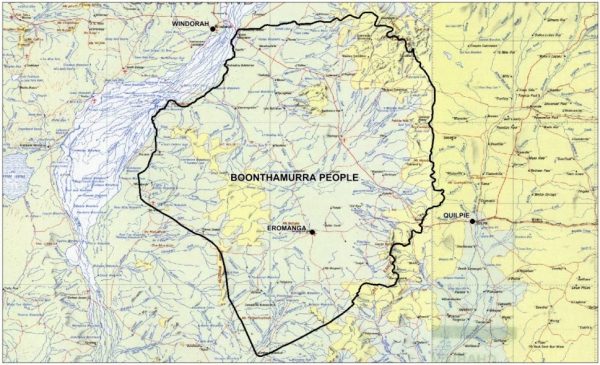Boonthamurra Native Title Determination
Native title is a form of Indigenous land rights that recognises Indigenous Australian’s ongoing connection to country, and our right to access our country to maintain this connection. To gain recognition of our native title rights and interests, the Boonthamurra people embarked on a nine-year journey through the Australian Federal Court, presenting physical, oral and written evidence of our continuing culture and connection to country.
On 25 June, 2015, the Boonthamurra people’s native title rights and interests were formally recognized in a consent determination made by the Federal Court. The determination of non-exclusive native title covered an area of more than 23 400 square kilometres of land and waters in the Channel country of South West Queensland, within the Quilpie, Barcoo, and Bulloo shires, and encompassing the town of Eromanga, and various pastoral stations.

First lodged in 2006, our native title journey highlighted the unbroken connection of Boonthamurra people to our traditional country, first documented by pastoralists in the 1860s, and surviving against all the odds of colonization and the frontier violence and forced removals this involved.
Boonthamurra People
Boonthamurra people are the contemporary descendants of two apical ancestors: Kangaroo and Dick Ray.
Boonthamurra Language
Boonthamurra (Punthamara) is a dialect of a language linguists call ‘Wangkumara-Punthamara’ or ‘the Wilson River language’, because it was spoken in the areas west and north of the Wilson River.
The dialects that make up this language include Wangkumara and Punthamara, as well as others that are no longer spoken, however the difference between the dialects is mostly a matter of pronunciation.
The Wangkumara-Punthamara language is related to the Karnic group of languages associated with the Lake Eyre Basin.
Boonthamurra Culture
Our culture and values are built around our connection and responsibility to Country, and to each other. The peoples of the Lake Eyre Basin, aside from being connected linguistically and geographically (via the rivers and their tributaries flowing into the basin) were also connected culturally, through the sharing of Mura stories, ceremonies (including initiations and other gatherings), intermarriages, and trade of goods like ochre and pituri.
Native Title Rights and Interests
The Boonthamurra People’s native title rights and interests include the right to:
These rights can be exercised by Boonthamurra individuals, groups or families, within the native title determination area (Boonthamurra Country). They also form the basis for negotiations between the Boonthamurra Native Title Aboriginal Corporation and proponents who wish to do things on Boonthamurra country that are likely to impede the exercise of these rights.
Boonthamurra Timeline
A timeline of key events in the history of the Boonthamurra People follows:


